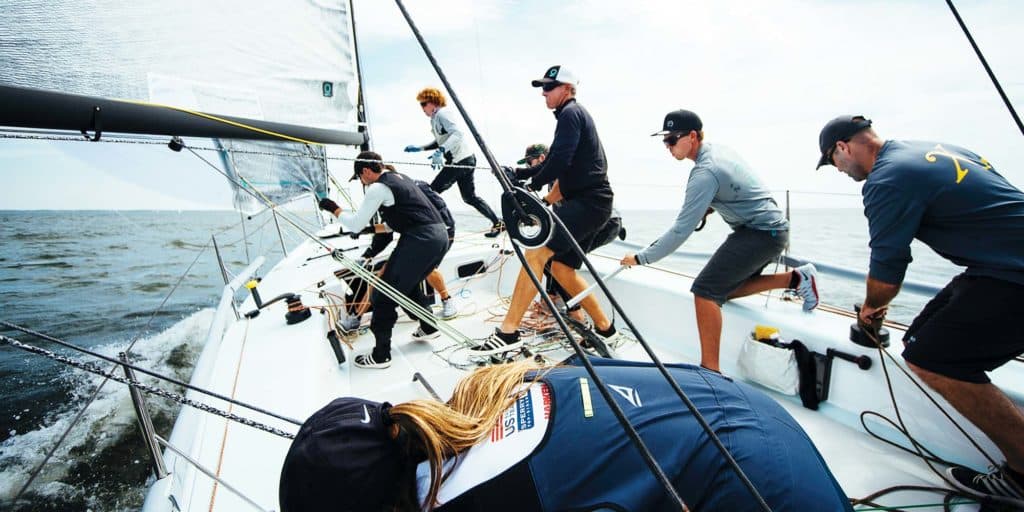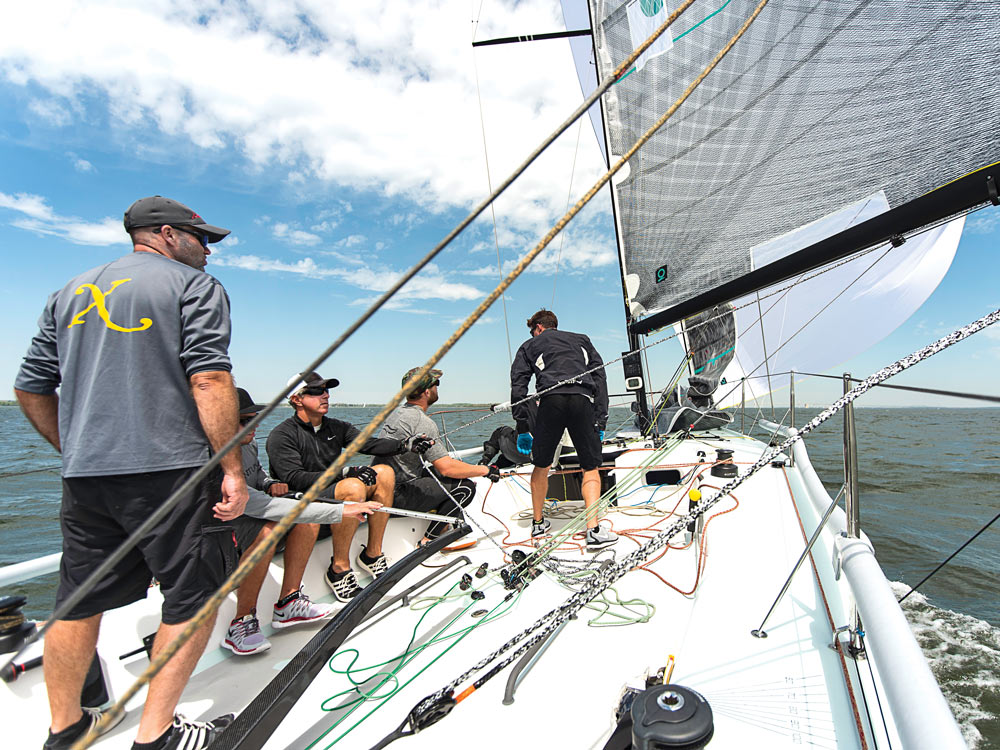
Part of my role as a pro sailor is helping others around me improve. My main goal when doing this is to make sure they are self-sufficient and don’t become robotic. We won’t achieve much if I have to keep saying “head up” or “head down” or “more trim” or “weight out.” I want them to reach a level where they know exactly what to do and when to do it. Then, we can limit our onboard conversation to calling plays. No specific details, only the outcome — just like in many other sports. Can you imagine football players in the huddle listening to the quarterback give each of them individual instructions as a play is run: “Hey, block that guy.” “Don’t let him through.” “Run over there, and I’ll throw the ball to you.”
It would never work. Yet, with often similar-size teams, we can end up doing exactly that before and during maneuvers. We’ve all raced with the guy who is always barking orders: “Starboard sheet on, now ease the port sheet!” and so on. Why not just say, “We’re jibing”? Identify the outcome, which empowers the team to do it better instead of focusing on the minutia of the maneuver.
In other words, just call the play.
A sailboat racer’s playbook is, again, much like in football. It’s a collection of plays we run that, with practice, can be started and completed with few words spoken, with everyone knowing what they need to do, and with the whole team on the same page about the outcome we desire. Here’s an example that happened to me recently: We were the smallest in a fleet of big boats, and coming off the starting line, one of those bigger boats was starting to sail over the top of us. We needed to tack away but were too close to the boat to windward. The solution was to do what is called a “drop tack.”
We bore off sharply, about 15 degrees or so, which created lateral separation with the windward boat. That gave us room to roll into a tack. If we hadn’t practiced that move and it wasn’t in our playbook, we’d run into two problems. First, we’d lose a lot of time explaining what we were going to do and what everyone’s job was in executing the maneuver. Second, we’d have people on the rail sitting up and wondering what was going on instead of hiking hard to help the boat bear off. Instead, we just called the play: “Drop tack.”
No other words were spoken. The helmsman put the bow down 15 degrees, the jib trimmer went outboard with the jib lead, the traveler went down and everyone on the rail hiked extra hard to help the boat bear away. The next move was trimming up and tacking over, which everyone was prepared for and did flawlessly. We’d practiced that move, and it was in our playbook.
A sailboat racer’s playbook is, again, much like in football. It’s a collection of plays we run that, with practice, can be started and completed with few words spoken.
Here’s another example: We had just rounded the windward mark and were sailing toward the offset mark, and our bow was overlapped with another boat to leeward of us. We wanted to do a jibe set at the offset mark, but with the other boat there, we would have to wait until they either cleared out or jibed away first. It was essentially the opposite of what we did with the drop tack — head up sharply to create some lateral distance with the other boat so that we would have room to do an immediate jibe set at the offset mark. Rather than having the crew look back at the helmsman, wondering what’s going on, and the trimmers having to respond abruptly to the change in course, we simply called the play, and everyone still knew what to do since we had called for a jibe set. Having discussed all of the details ahead of time and then simply calling the play when the time comes always produces the smoothest boathandling.
To make play calling work, though, be sure what you’re saying has been received. On most boats I sail aboard, the crew simply responds with the word “copy,” and I know they’ve heard me. On much bigger boats, where crews can number in the 20s, I’ll have a specific person picked out, usually positioned about halfway between me and the forward-most crewmember, to whom I’ll direct the play call. They’ll respond with “copy” and then relay the play to the crewmembers forward of him.

There are different types of playbooks you can create. You can set up one devoted entirely to what each crew or the helmsman does. Those are detail-oriented, focused on individual jobs, and they’re important in their own way. But there’s also the big-picture playbook, which we’re talking about here, and that’s what I always want the crew to understand. The plays are a place to start the conversation. The calls are all normal maneuvers in racing. Play calling just simplifies the communication. As in football, it’s not detailing exactly how you’re going to block someone, but instead the desired outcome of the play. And just as Tom Brady and every other quarterback carry the repertoire of plays on their armbands, having a list of plays that you and your crew have practiced will make dealing with those third-and-goal situations a lot more successful.
Sample play calls and what they mean.
In the Start
Double tack: Two successive tacks
Wind shot: Head-to-wind breeze check
Head-to-wind: Hold bow into the wind
Accelerate: Trim sails, speed build
Hook: Setup with bow underneath an opponent’s leeward quarter
On the Upwind Leg
Tack: Full-speed maneuver
Drop tack: Pre-determined bear-away angle; immediately followed by a tack
Dip: Passing behind a competitor
Leebow: Tacking into a controlling position ahead and to leeward of a component
Downwind Moves
Jibe: Angle-to-angle jibe
Blow-through jibe: Hold the weather sheet longer before release, allowing sail to lay against the headsail. Useful in strong winds.
Up and behind: Sail a brief high course to pass behind another competitor in order to switch relative positions.
Speed Loop
Soak: Sail artificially lower.
VMG mode: Sail optimal course and speed to the mark.
Heat mode: Sail a slightly higher downwind angle to build speed.
Footing mode: Sail a slightly lower course for tactical or performance reasons.
Pointing mode: Sail a slightly higher course: to be used for tactical or personal.
Depower: Adjust rig and sails to depower the sail plan in order to maintain efficient speed and height.
Power up: Adjust rig and sails to accept a more powerful sail shape.
Around the Corners
Bear-away set: Standard rounding; spinnaker hoist and best exit angle
Jibe set: Weather mark move where spinnaker is hoisted while on starboard
Mexican: Jibing and dropping the sail at the leeward mark after laying it in the foresail keeps it in the boat.
Windward drop: Pulling the spinnaker down into the boat (make sure guy is free to run)
Leeward drop: Standard spinnaker down behind the mainsail
Left-hand turn (gate): Round left-hand mark (looking downwind)
Right-hand turn (gate): Round right-hand mark (looking downwind)
Apex turn: In-tight, out-wide mark exit
Other Essentials
Luff: Turn and ease sails to luff and slow/stop forward progress.
Bear away: Turn the boat away from the wind, no more than 20 degrees.
Penalty turn: It’s what you do when you foul someone: one tack, one jib; if you’re penalty is upwind, it’s faster to tack. You want the opposite on a downwind leg; start with jibe.









